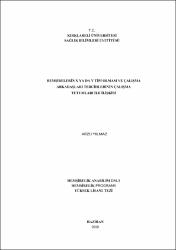Hemşirelerin X ya da Y Tipi Olması ve Çalışma Arkadaşları Tercihlerinin Çalışma Tutumları ile İlişkisi

Göster/
Erişim
info:eu-repo/semantics/openAccesshttp://creativecommons.org/licenses/by/3.0/us/Tarih
2019-06Üst veri
Tüm öğe kaydını gösterKünye
Yılmaz,A.(2019).Hemşirelerin X ya da Y Tipi Olması ve Çalışma Arkadaşları Tercihlerinin Çalışma Tutumları ile İlişkisi.Kırklareli Üniversitesi Sağlık Bilimleri Enstitüsü, Kırklareli.Özet
Hemşirelerin X ya da Y Tipi Olması ve Çalışma Arkadaşları Tercihlerinin Çalışma Tutumları ile İlişkisi Bu araştırma, hemşirelerin McGregor X ya da Y Teorisi varsayımlarına yönelimli olma durumları ve çalışma arkadaşları tercihlerinin çalışma tutumları ile ilişkisinin belirlenmesi amacıyla gerçekleştirilmiştir. Araştırmanın evrenini bir tıp fakültesi hastanesi, üç devlet hastanesi ve iki özel hastanede çalışmakta olan hemşireler oluşturmuştur. 18 yaşından büyük ve en az altı aydır hemşirelik mesleğini icra eden katılımcılar arasından çalışmaya katılmayı kabul eden ve anket formunu eksiksiz olarak dolduran 280 hemşire araştırmanın örneklemini oluşturmuştur. Verilerin toplanmasında katılımcıların, sosyo-demografik, kişisel ve mesleki özelliklerine ilişkin sorular, McGregor X/Y Teorisini temel alan ölçüm aracı, “En Az Tercih Edilen Çalışma Arkadaşı (Least Preferred Co-worker (LPC)) Ölçeği” ve “Çalışma Tutumu Ölçeği (ÇTÖ)”nden oluşan anket formu kullanılmıştır. Verilerin istatistiksel analizi NCSS (Number Cruncher Statistical System) 2007 programı kullanılarak yapılmıştır. Çalışma verilerini değerlendirirken: normallik analizi, tanımlayıcı istatistikler, geçerlik ve güvenirlik analizleri, ki-kare analizi, ikili ve çoklu gruplar arasında farkın anlamlılık testleri, korelasyon ve moderatör/düzenleyici etki için çoklu grup modellemeleri kullanılmıştır. Çalışmaya katılan hemşirelerin %47,1’ini oluşturan bölümü 25-34 yaş aralığında, %83,9’u kadın, %67,1’i lisans mezunu, %57,5’i devlet hastanesi, %63,9’u kadrolu, %78,2’si servis hemşiresi, %40’ı 0-5 yıldır hemşirelik mesleğinde çalışıyor, %70’ı gündüz/gece değişen vardiyalar şeklinde çalışıyor, %44,3’ünün aylık geliri 2501-5000 Türk Lirası (TL) dır. Hemşirelerin işten ayrılmayı düşünmeyenlerin oranı %20 ve %68,9’u ekip çalışmasını bozan arkadaşları olduğunu belirtmiştir. Hemşireler arasında ekip çalışmasının varlığına yönelik algı düzeyi, ekip çalışmasından memnuniyet düzeyi, çalışma arkadaşlarından memnuniyet düzeyi ve iş doyumları orta düzeydeyken yüksek düzeyde iş yükü algıları ve iş kaynaklı stres algısı düzeyine sahip oldukları belirlenmiştir. Çalışmada kullanılan üç ölçüm aracının birbirleri ile olan ilişkileri incelendiğinde; Çalışmada LPC ölçeği toplam puanı ile Y Teorisi varsayımları arasında anlamlı ilişki saptanamamış iken; X teorisi varsayımları ile negatif yönlü anlamlı zayıf ilişki saptanmıştır. LPC ölçeği ile ÇTÖ arasındaki ilişki incelendiğinde; LPC ölçeği toplam puanı ile ÇTÖ Mistik Yönelimli (MY)-Teslimiyetçi, Kolay Kazanç Yönelimli (KKY)-Hazcı, İş Yönelimli (İY)-Çileci ve toplam çalışma tutumu puanları arasında istatistiksel olarak anlamlı ilişki saptanamamıştır (p>0,05). LPC ölçeğinin, dil ve kapsam geçerliliği, yapı geçerliliği çalışılarak, literatürle uyumlu güvenilir bir araç olduğu belirlenmiştir. X Teorisi varsayımlarına yönelimli olan hemşirelerin KKY-Hazcı Çalışma Tutumunu benimsedikleri görülmekle birlikte; Y Teorisi varsayımlarına yönelimli hemşirelerin KKY-Hazcı Çalışma Tutumundan uzaklaştıkları, İY-Çileci Çalışma Tutumu’nu benimsedikleri görülmektedir. Anahtar sözcükler: Hemşirelik, X ya da Y tipi, Çalışma arkadaşı tercihi, Çalışma tutumu Correlation of X or Y Type of Nurses and Their Coworkers’ Preferences With Their Working Attitudes This study was carried out for the purpose of determining the correlation between nurses’ tendency to assumptions of the McGregor X or Theory Y, co-worker’s preferences and working attitudes. Target population of the study consisted of nurses working in a medical faculty hospital, three public hospitals and two private hospitals. 280 nurses who were older than 18 years, had been performing the profession of nursing for at least six months, accepted to participate in the study and filled in the questionnaire form thoroughly constituted the study sample. Data were collected using questions about socio-demographic, personal and professional characteristics of the participants, a measurement tool based on the McGregor Theory X/Y, “Least Preferred Co-worker (LPC) Scale” and a question form consisting of the “Working Attitude Scale (WAS)”. Statistical analysis of the data was performed using the NCSS (Number Cruncher Statistical System) 2007 program. The study data were evaluated using: normality analysis, descriptive statistics, validity and reliability analyses, chi-square analysis, significance tests of the difference between dual and multiple groups and multiple group modellings for the correlation and moderator/regulatory effect. It was determined %47,1 of the nurses who participated in the study were in the age range of 25-34 years, %83,9women, %67,1 bachelor, %57,5 worked in a public hospital, %63,9 were staffed nurse, %78,2 service nurse, %40 had been working in the profession of nursing for 0-5 years, %70 worked in day/night shifts and %44,3 had a monthly income of 2501-5000 Turkish Liras (TL). %20 of the nurses did not consider quitting their job and %68,9 stated that some of their co-worker’s spoiled the team work. It was determined that the nurses had moderate levels of perception concerning the presence of team work, satisfaction with team work, satisfaction with co-workers and job satisfaction and higher levels of work load perception and workrelated stress perception. Examining the interrelation of the three measurement tools used in the study; it was determined that there was no significant correlation between xix the total score of the LPC scale and assumptions of the Theory Y, whereas there was a negatively significant and weak correlation with assumptions of the Theory X. Examining the interrelation of the LPC scale and the WAS scale; it was determined that there was no statistically significant correlation between the total score of the LPC scale and the WAS Mystic Oriented-Submissive, Easy Earning OrientedHedonist, Work Oriented-Ascetic and the total working attitude scores (p>0,05). Working on the language, content and construct validity of the LPC scale; it was found that the scale was a reliable instrument in accordance with the literature. It was seen that the nurses who had a tendency to assumptions of the Theory X adopted the Easy Earning Oriented-Hedonist Working Attitude, whereas the nurses who had a tendency to assumptions of the Theory Y receded from the Easy Earning OrientedHedonist Working Attitude and adopted the Work Oriented-Ascetic Working Attitude. It is believed that there is a need for value-based standardized education and fair performance evaluation systems in the processes of training, placing and developing human resources that will perform the profession of nursing, which is labor-intensive, has a complex work load, requires a different competence, compels to work under an uncertainty, stress and time pressure and in return, provides limited possibilities of giving financial rewards.
Koleksiyonlar
- Tez Koleksiyonu [52]
Aşağıdaki lisans dosyası bu öğe ile ilişkilidir:



















